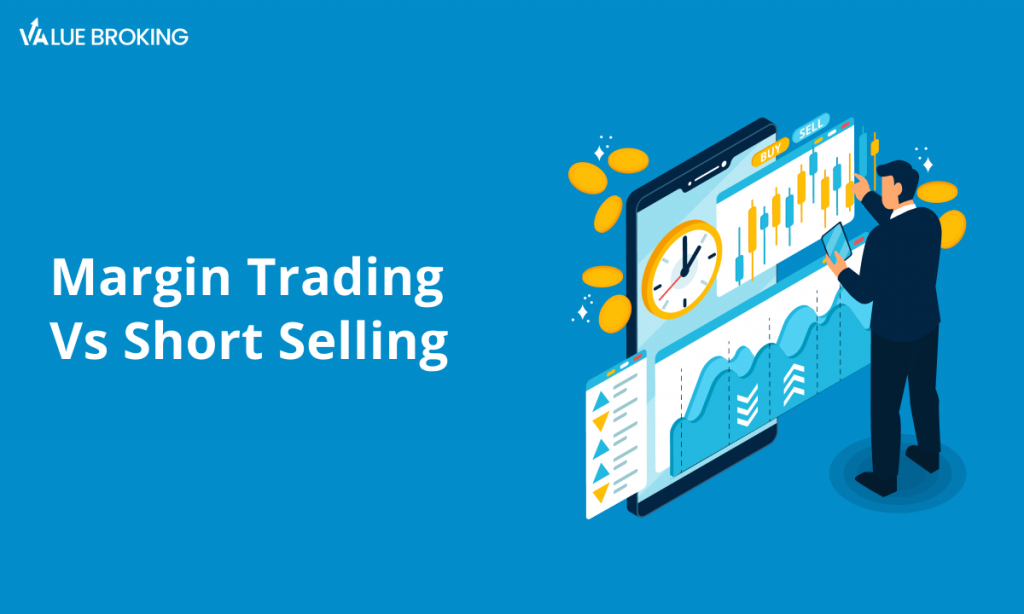Margin Trading Vs Short Selling

It is obvious to get confused between short-selling and margin trading when you enter the stock market in India. However, there are similarities between margin trading and short trading. You carry out margin and short trading very well and make profits.
Let’s discuss these trades in detail.
Table of Contents
Margin Trading
Margin trading means taking money from a brokerage company to buy stocks and, in simple words, taking a loan to buy stocks to return them with interest at a future date. Margin trading allows you to take advantage of leverage to profit in the market. You can invest more money in margin trading than having your brokerage account. It means you pay a fractionable value for many stocks. There is a chance to specify losses when an investment doesn’t perform as predicted. Another name for margin trading is margin funding, while the specific money you pay in margin trading is margin money. However, the margin requirement you have for stocks, futures, options, and currencies varies, but there will be no difference in the underlying principle.
Margin trading is straightforward, but there is significant risk involved. You need to approach a stockbroker to open a margin account to perform margin trading. There is a significant difference between a margin account and an ordinary cash account. To perform short sales, you must use margin accounts.
Short Selling
It is obvious to opt for a long-term investment when you expect its price will go up. Conversely, choosing a short-term investment means predicting a share price will fall in price. Short selling allows you to sell a stock you don’t own, but you have to deliver it.
In short-selling, you will get stock from your stockbroker. This stock can be from the following three places-
- The brokerage’s inventory
- Another one of the firm’s customers
- Another brokerage firm
After selling shares, you will get proceeds credited to your account. After a reasonable period, you would like to close it to profit. You have to repurchase the same number of shares and return them to your broker means closing short selling. If the stock price falls, you repurchase the stock to avail of the price difference.
There may be a situation when you feel the compulsion to cover if the lender wants you to return the borrowed stock. Without owning the stock you borrowed, you sold it; here, you will have to pay any dividends or other rights mentioned while the loan’s course to the lender. You have to understand the terms and conditions of short selling your stockbroker. Splitting the stock at the time of short means having the number of shares double at half the price.
You need to use a margin trading account to participate in short selling like margin trading. If there are no shares of any XYZ company in your Demat account, still you can sell it through a margin account.
Both margin trading and short selling involve risks. This is the reason only the pro traders take up these kinds of trading practices. But if you want to start, begin with small steps – research, learn, and practice before using these advanced methods.
What is the Difference Between Margin Trading and Short Selling?
To understand the difference between margin trading and short selling, you need to understand its advantages and disadvantages briefly.
Advantages of Margin
- You should plan your trade carefully to maximize your returns based on the size of the securities you own.
- You can also avail yourself of declining in the share market.
- You can trade whenever you want; there is no need for additional forms and documentation.
- There is a chance of leveraging idle stocks as collateral for making larger trades and gaining from them.
- You can use shares as securities to receive additional margins online.
Disadvantages of Margin
Although participating in margin trading is lucrative as a leverage system, there is an equally high chance of risks. For example, you can lose during adverse price movements. Therefore, you should research before you take part in margin trading.
Advantages of Short Selling
- Offers liquidity to the markets that help reduce prices of stocks, improve bid-ask spreads, and price discovery.
- Protects the long-term exposure of an existing portfolio
- Minimizes the portfolio’ overall market exposure
- The manager can make use of capital proceeds for overweighting the portfolio’s long-only component
- A portfolio’s overall volatility can lessen due to long and short positions exposure.
- You can have meaningful risk-adjusted returns.
Disadvantages of Short Selling
- There is inherent volatility in short selling. There is a possibility for a stock going zero, and this condition is rare.
- There is a reversion in stock price. There can be a quick and significant turnaround.
A “margin account” is a brokerage account by which you will receive money from your broker. Through this account as collateral, you can buy stocks. As a result, you can gain increasing purchasing power and get potential exposure for making significant losses.
Conclusion
Margin trading allows you to borrow money from a stockbroker to buy a stock, while in short selling, you sell a stock by borrowing it. In margin trading, you can invest more money in your brokerage account, whilst in short selling, you borrow shares from your stockbroker, and he will sell them as per your request.